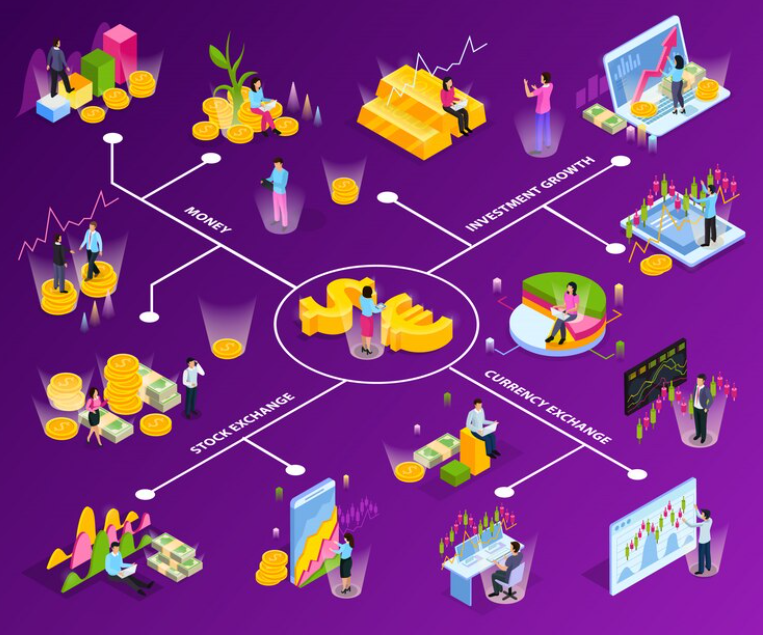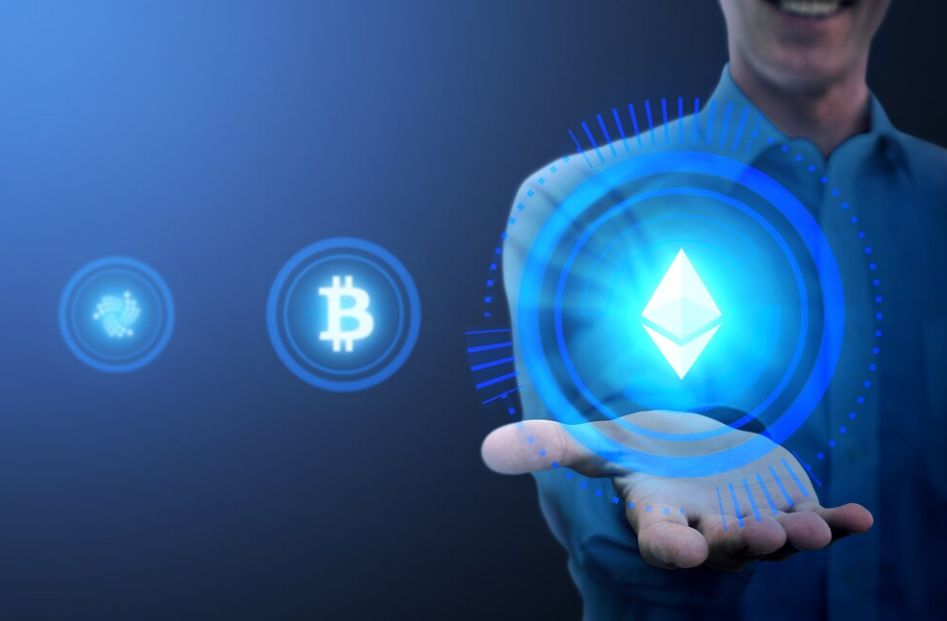
In recent years, the financial landscape has undergone a profound transformation, with decentralized finance (DeFi) emerging as a disruptive force poised to reshape traditional banking and investment practices.
DeFi represents a paradigm shift in how individuals access financial services, conduct transactions, and participate in the global economy, all powered by blockchain technology and smart contracts.
However, navigating the rapidly evolving DeFi space can be daunting. With an ever-growing array of projects, protocols, and platforms, investors are faced with the challenge of assessing DeFi technology correctly and distinguishing between innovative opportunities with future growth prospects and potential pitfalls.
Understanding how to evaluate and invest in DeFi projects is essential for capitalizing on this transformative trend while managing risks effectively.
Understanding Decentralized Finance

Source: Freepik
Decentralized Finance represents a transformative force in the financial landscape, offering innovative solutions that challenge traditional banking and investment paradigms. In this text, we'll explore the fundamentals of DeFi, its various project types, and how it compares to traditional investment opportunities.
DeFi projects and their role in the decentralized finance ecosystem
At its core, DeFi leverages blockchain technology to create open, permissionless financial systems that operate without intermediaries. A DeFi crypto project aims to democratize access to financial services, promote financial inclusion, and eliminate barriers to entry.
By utilizing smart contracts (self-executing contracts that run on blockchain networks), a DeFi protocol facilitates peer-to-peer transactions, lending, borrowing, and trading in a trustless manner, without the need for traditional financial institutions.
Different types of DeFi projects
DeFi networks encompass a diverse range of innovative scalable DeFi applications and protocols that aim to revolutionize traditional financial services. Here are some of the key types of DeFi projects.
Decentralized Exchanges (DEXs)
DEXs facilitate peer-to-peer trading of digital assets without the need for intermediaries. These platforms utilize smart contracts to enable trustless transactions, giving users unprecedented control over their funds.
Examples include Uniswap, SushiSwap, and PancakeSwap.
Lending and borrowing platforms
DeFi lending platforms allow users to lend or borrow digital assets and DeFi tokens directly from one another, without relying on banks or other financial institutions. Users can earn interest on their deposited assets or access liquidity by collateralizing their holdings.
Examples include Compound, Aave, and MakerDAO.
Yield farming protocols
Yield farming involves providing liquidity to popular DeFi protocols thus becoming liquidity providers in exchange for a predetermined monetary reward, often in the form of additional DeFi tokens or yield generated from transaction fees.
Users can maximize their returns by strategically allocating their assets across various liquidity pools and DeFi protocols.
Examples include Yearn.Finance, Harvest Finance, and Curve Finance.
Synthetic assets platforms
Particular DeFi protocol types offer synthetic assets that allow users to gain exposure to a wide range of assets, including commodities, fiat currencies, stocks, and indices, without actually owning the underlying assets.
These platforms use smart contracts to create and trade synthetic versions of real-world assets.
Examples include Synthetix and Mirror Protocol.
Comparison of DeFi with traditional investment opportunities

Source: Freepik
Comparing DeFi with traditional investment opportunities reveals distinct differences and similarities, each with its advantages and drawbacks. Here's a comparison.
Accessibility
DeFi offers global access to financial services without the need for intermediaries like banks or brokers. Anyone with an internet connection and a crypto wallet can participate, promoting financial inclusion.
Traditional investments often require a certain level of wealth or accreditation, limiting access to a select few. Moreover, access may be restricted by geographic location or regulatory barriers.
Transparency
DeFi operates on public blockchain networks, providing transparent and immutable transaction records. Smart contracts enforce rules and ensure transparency, enhancing trust among users.
Traditional financial systems can lack transparency, with opaque processes and hidden fees. Investors may have limited visibility into the inner workings of investment vehicles and intermediaries.
Innovation
Multiple decentralized applications drive innovation by exploring new financial instruments, automated protocols, and decentralized governance models. Continuous experimentation leads to the development of novel solutions and improved efficiencies.
Traditional investment opportunities may be slower to innovate due to regulatory constraints and entrenched systems. However, innovation still occurs, albeit at a more gradual pace.
Control
DeFi empowers users with greater control over their funds and investments. Users maintain custody of their assets and can interact directly with protocols without relying on third parties.
Traditional investments often involve relinquishing control to intermediaries such as brokers, custodians, and fund managers. While these professionals may provide expertise, investors ultimately delegate decision-making authority.
Risks
DeFi is still in its nascent stages and faces risks such as smart contract vulnerabilities, regulatory uncertainty, and market volatility. Users must conduct thorough due diligence and exercise caution when engaging with DeFi protocols.
Traditional investments also carry risks, including market fluctuations, economic downturns, and counterparty risks. However, regulatory protections and institutional safeguards may mitigate some of these risks.
How to Evaluate a DeFi Project

Source: Freepik
Evaluating a DeFi protocol requires a comprehensive understanding of its underlying technology, governance structure, tokenomics, team, community, and market dynamics. Here's a step-by-step guide on how to evaluate a DeFi protocol.
Understand the problem and the solution offered by the DeFi protocol
Identify the problem the DeFi project aims to solve and assess the viability of its proposed solution. Evaluate whether the project addresses a genuine market need and offers unique value compared to existing solutions.
Assess the technology
Examine the underlying technology stack, including blockchain platforms, smart contracts, and protocols. Evaluate the security and robustness of the smart contracts to mitigate the risk of vulnerabilities and exploits. Analyze the scalability, interoperability, and performance of the technology to ensure it can handle growing demand and usage.
Review the governance model
Understand the project's governance structure and decision-making processes. Assess whether governance is decentralized, transparent, and inclusive, allowing community members to participate in protocol upgrades and decision-making. Evaluate the effectiveness of governance mechanisms in resolving disputes, implementing upgrades, and maintaining protocol integrity.
Analyze tokenomics
Examine the tokenomics of the project, including token distribution, inflationary or deflationary mechanisms, the mechanism of maintaining token scarcity, and utility within the ecosystem. Assess the economic incentives for token holders, such as staking rewards, governance rights, and fee sharing. Evaluate the long-term sustainability and scarcity of the token supply to gauge its potential value proposition.
Investigate the team
Research the background, experience, and track record of the project's founding team and key contributors. Assess the team's expertise in blockchain technology, finance, cryptography, and relevant domains.
Verify the team's commitment to the project and assess team's efforts and abilities to execute the roadmap effectively.
Engage with the community
Join the project's community channels, such as Discord, Telegram, forums, and social media platforms to interact with other participants who can provide valuable insights.
Evaluate the level of community engagement, activity, and support for the project to check the overall market acceptance and determine potential vulnerabilities. Pay attention to community sentiment, feedback, and discussions regarding the project's development, updates, and challenges. A thriving community is a sign of a healthy project.
Conduct due diligence
Perform thorough due diligence on the project's whitepaper, technical documentation, and audit reports. Verify the project's compliance with regulatory requirements and assess any legal risks associated with its operation. Scrutinize third-party reviews, analyst reports, and media coverage to gather additional perspectives and insights.
By following these steps and conducting thorough research and analysis, investors can make informed decisions when evaluating DeFi projects and mitigate risks associated with this dynamic and rapidly evolving space.
Risk Assessment

Source: Freepik
Risk assessment is crucial when considering investments in a DeFi protocol due to the unique challenges and uncertainties inherent in this emerging sector. Here's a breakdown of identifying and understanding risks associated with DeFi investments, along with strategies for mitigating these risks.
Smart contract risks
Smart contracts are the backbone of many DeFi projects and are susceptible to vulnerabilities, coding errors, and exploits. Risks include bugs, loopholes, and security flaws that could result in financial losses or theft of assets. Implementing bug bounty programs is a common solution for projects to mitigate the risks.
Market volatility
DeFi tokens are often subject to high levels of price volatility, driven by factors such as market sentiment, speculation, and external events. Rapid price fluctuations can lead to significant gains or losses for investors, posing inherent risks to investment capital.
Regulatory uncertainty
DeFi operates in a rapidly evolving regulatory landscape, with potential legal and compliance risks. Regulatory actions, enforcement measures, and policy changes could impact the legality, operation, and adoption DeFi and hinder investors in making informed investment decisions.
Liquidity risks
Liquidity is one of the key aspects of a project that motivates the project's community and users and is a good stimulus for investors to acquire DeFi tokens. Each DeFi project relies on liquidity providers to facilitate trading, lending, and borrowing activities. Illiquid markets or sudden withdrawal of liquidity can result in slippage, price manipulation, and difficulty in executing trades.
Economic risks
A DeFi protocol may be susceptible to economic risks such as inflation, deflation, and monetary policy changes. Economic downturns, market shocks, and systemic risks could impact the stability and sustainability of DeFi protocols.
Strategies for mitigating investment risks in DeFi projects
To mitigate the risks of investing in a DeFo protocol, follow these tips.
Thoroughly research and analyze the project before investing, including its technology, team, governance, and tokenomics.
Review audit reports, security assessments, and third-party evaluations to assess the project's security measures.
Spread investment capital across multiple DeFi projects to mitigate concentration risk and exposure to individual assets or protocols.
Stay informed about market trends, regulatory developments, and ecosystem dynamics that could impact DeFi investments.
Implement risk management strategies such as setting stop-loss orders, using hedging instruments, and adjusting investment portfolios based on changing market conditions.
Select reputable DeFi platforms with a track record of security, reliability, and user trust.
Due Diligence and Research

Source: Freepik
Conducting thorough due diligence before investing in a decentralized finance (DeFi) project is paramount for several reasons.
Thorough due diligence helps investors identify and understand the risks associated with DeFi investments. By assessing these risks upfront, investors can make informed decisions and take appropriate measures to mitigate potential losses.
Due diligence enhances investor protection by providing a deeper understanding of the project's fundamentals, technology, team, and market dynamics. This knowledge enables investors to assess the project's viability, credibility, and long-term potential, reducing the likelihood of investment losses and scams.
A transparent and trustworthy DeFi protocol prioritizes openness, accountability, and community engagement. Through due diligence, investors can evaluate the project's transparency, governance structure, and communication practices, fostering trust between investors and project teams.
Successful investments in DeFi require a thorough understanding of the project's objectives, technology, competitive landscape, and market trends. By conducting due diligence, investors can assess the potential for long-term success, sustainability, and growth of DeFi projects, thereby maximizing investment returns and minimizing risks.
Regulatory compliance is increasingly important in the DeFi space, with regulators scrutinizing projects for compliance with securities laws, anti-money laundering (AML) regulations, and know-your-customer (KYC) requirements. Thorough due diligence helps investors verify the project's compliance with relevant regulations and assess any legal risks associated with its operation and token offerings.
Overall, conducting thorough due diligence before investing in a DeFi project is essential for protecting investment capital, mitigating risks, and maximizing returns in this rapidly evolving and high-risk environment. By leveraging research tools, resources, and best practices, investors can make informed decisions and navigate the complexities of the DeFi ecosystem with confidence.
Regulatory Considerations
The regulatory landscape for DeFi is characterized by ambiguity and uncertainty, with regulations varying significantly across jurisdictions. Regulators worldwide are grappling with the novel and complex nature of DeFi, leading to a lack of clear guidance on how existing regulations apply to decentralized protocols and token offerings.
DeFi projects may encounter regulatory scrutiny under securities laws, particularly if their DeFi token is deemed to be securities. The Howey Test and similar criteria are often used to determine whether a DeFi token qualifies as a security, based on factors such as investment of money, expectation of profits, and reliance on the efforts of others.
Also, DeFi projects may face regulatory obligations related to AML and KYC requirements, particularly if they involve the exchange or transfer of digital assets. Compliance with AML/KYC regulations helps mitigate risks associated with money laundering, terrorist financing, and other illicit activities.
Regulators are concerned about consumer protection in the DeFi space, particularly regarding investor education, transparency, and disclosure of risks. Projects that offer financial products or services to retail investors may be subject to regulations aimed at safeguarding consumers' interests and preventing fraud and abuse.
Tax treatment of DeFi transactions and income varies by jurisdiction and may be subject to capital gains tax, income tax, or other tax liabilities. Regulatory clarity on tax implications for DeFi participants is essential to ensure compliance and avoid potential tax liabilities.
Implications of Regulatory Changes on DeFi Investments

Source: Freepik
Regulatory changes may impose compliance costs on DeFi projects, including legal fees, regulatory filings, and compliance personnel.
However, it doesn't necessarily guarantee security. Additionally, higher compliance costs could impact project profitability and resource allocation, particularly for smaller or decentralized teams.
Market access
Regulatory changes may affect market access for DeFi projects, with regulators imposing restrictions or requirements that limit participation or investment in a specific DeFi protocol or in DeFi in general in certain jurisdictions.
Compliance with regulatory requirements may be necessary to access traditional financial markets, institutional investors, and mainstream adoption and thus is a crucial aspect to pay attention to when assessing the project's potential.
Innovation and development
Regulatory uncertainty and constraints may hinder innovation and development in the DeFi space, as projects navigate legal and compliance challenges. Clear and balanced regulation can provide a framework for innovation while protecting investors and mitigating systemic risks.
Investor confidence
Regulatory changes can impact investor confidence and sentiment towards DeFi investments, with uncertainty leading to market volatility, inability to identify investment opportunities, and reduced investment activity.
Clarity and consistency in regulatory frameworks can help build trust and confidence in the DeFi ecosystem, attracting capital and fostering growth by taking the needed security measures to protect user funds.
Adaptation and compliance
DeFi projects must adapt to regulatory changes and comply with evolving regulations to mitigate legal and regulatory risks. Proactive engagement with regulators, legal counsel, and industry stakeholders can help projects navigate regulatory challenges and ensure compliance with applicable laws.
In summary, the regulatory landscape for DeFi projects is complex and evolving, with implications for compliance, market access, innovation, investor confidence, and project development. Understanding regulatory considerations and adapting to regulatory changes are essential for navigating the regulatory environment and maximizing opportunities in the DeFi space.
Case Studies and Examples
Successful DeFi Projects
The most successful DeFi financial applications are the following.
Compound Finance
Compound is a decentralized lending protocol that allows users to borrow and lend digital assets.
It gained significant traction due to its efficient interest rate mechanism and governance model, attracting billions of dollars in total value locked (TVL).
Uniswap
Uniswap is a decentralized exchange (DEX) protocol that enables users to swap ERC-20 tokens directly on the Ethereum blockchain. It became one of the most popular decentralized exchanges due to its user-friendly interface, liquidity pools, and decentralized governance.
Aave
Aave is a decentralized lending and borrowing platform that offers a wide range of crypto assets including various DeFi token types as collateral. It gained popularity for its innovative features, such as flash loans and decentralized governance, contributing to its success in the DeFi space.
Failed DeFi projects
Yam Finance
Yam Finance was a DeFi project that aimed to create a decentralized stablecoin with an elastic supply. However, a critical flaw, one of the valid security vulnerabilities led to a governance failure and the collapse of the project, resulting in significant losses for investors.
Hegic
Hegic was a decentralized options trading platform built on Ethereum. Despite its promising concept, it struggled with low liquidity, user adoption, and technical issues, leading to its eventual problems with asset management, decline, and discontinuation.
By learning from real-world examples and past investment experiences, investors can navigate the complexities of the DeFi space more effectively, minimize risks, and capitalize on opportunities for growth and innovation.
Conclusion
Investing in decentralized finance projects offers exciting opportunities for growth and innovation, but it also carries inherent risks and uncertainties.
For DeFi users, it's essential to approach DeFi investments with a well-informed and cautious mindset to mitigate risks and make informed decisions.
Conduct thorough due diligence, research, and analysis before investing, and be mindful of the potential for market volatility, regulatory changes, and technological risks. Diversify investments, manage risks, and stay informed about market developments to navigate the complexities of the DeFi ecosystem effectively. By staying vigilant, prudent, and disciplined, investors can maximize opportunities for success while minimizing exposure to potential losses.











